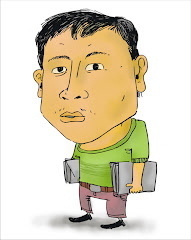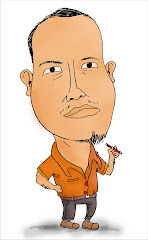Dari Jurnal Nasional
by : Heru Prasetya
MASA lalu sulit air di Dusun Sanan, Desa Bawuran, Kecamatan Pleret, Kabupaten Bantul, DI Yogyakarta berakhir sudah. Tidak ada lagi warga yang harus berjalan kaki sejauh tiga kilometer hanya untuk mandi atau mengambil air bersih. Kini, mereka yang tinggal di tempat paling tinggi pun sudah memiliki kran dengan air siap mengalir kapan pun diperlukan. Putar kran...dan mengalirlah air...
Begitulah gambaran warga setempat. Tempat paling tinggi di dusun ini masuk wilayah RT 05, dengan ketinggian 1.350 meter di atas permukaan air laut. Jumlah penduduk di dusun ini sekitar 1.500 jiwa terbagi dalam 450 kepala keluarga, tersebar di tujuh RT.
“Masalah bertahun-tahun di Dusun Sanan adalah air. Tidak mudah bagi mereka untuk memperoleh sepercik air. Bahkan gempa yang menerjang Bantul tahun 2006 lalu, pengaruhnya sangat besar terhadap ketersediaan air di sini karena banyak sumber air yang kemudian kering,” jelas Suripto, Kepala Desa Bawuran, Jumat pekan lalu.
Pengakuan diungkapkan Tarmudzi (63) warga RT 05. Laki-laki renta tapi masih enerjik ini mengaku harus berjalan kaki sekitar tiga kilometer ‘“ atau enam kilometer pulang pergi ‘“ untuk mandi. Satu-satunya sumber air yang tersedia pun tidak lagi di Dusun Sanan, tetapi masuk wilayah Dusun Kedungpring.
“Ke sana saya berjalan kaki, biasanya yang ngantri sudah banyak orang sehingga harus menunggu terlebih dahulu sebelum sampai tiba giliran mandi. Setelah mandi, saya menyempatkan mengisi satu derijen dengan air bersih untuk persediaan di rumah. Kemudian pulang sambil membawa derijen tadi. Sampai di rumah sudah berkeringat lagi,” jelas Tarmudzi kepada Jurnal Nasional di sebuah tanjakan dekat rumahnya.
Hal senada juga diungkapkan Sunarto (65), juga warga RT 05. Ia bahkan mengisahkan, banyak tetangganya lebih mementingkan ternak yang dimiliki dalam hal pemenuhan kebutuhan air bersih ketimbang untuk diri sendiri. Maksudnya, memberi minum ternak ‘“ pada umumnya adalah lembu ‘“ didahulukan, baru kemudian urusan mandi pemilik ternak itu sendiri.
Sehingga, menurut Tarmudzi maupun Sunarto, dalam sehari paling banter hanya mandi satu kali. Tentang kapan mandi dilakukan, sangat tergantung kepada kebutuhan. Biasanya mandi dilakukan beberapa saat sebelum bepergian. Jika tidak bepergian, mandi dilakukan jika kebetulan sedang melewati sumber air bersih.
Sanan memang termasuk dusun terpencil. Jarak dari Kota Bantul sekitar 20 kilometer ke arah timur. Sedangkan dari perempatan Terminal Terpadu Giwangan Yogyakarta ke arah selatan sekitar 15 kilometer. Perempatan Wonokromo ke timur sekitar lima kilometer, kemudian ke selatan. Setelah melalui jalan berkelok-kelok di kaki Pegunungan Seribu, sampailah di dusun ini.
Selain Sanan, ada dusun lain di Desa Bawuran yang juga kesulitan air bersih yaitu Sentulrejo dengan 300 kepala keluarga dan Jambon dengan 400 kepala keluarga. Desa Bawuran terdiri dari tujuh dusun dengan sekitar 2008 kepala keluarga. “Secara geografis, Dusun Sanan ada di bagian atas dibanding dusun-dusun lain,” jelas Suripto.
Bantuan AmeriCares (LSM asal Amerika Serikat) melalui Yayasan xxxxxxxxx Yogyakarta sebesar US$95.000 (Rp855 juta) memicu warga setempat untuk bahu-membahu mengatasi persoalan air bersih. Awalnya tidak mudah menyatukan pendapat warga Sanan, karena warga bawah (maksudnya yang tinggal di tempat bawah) sulit menerima program pengangkatan air bersih. Sebagian warga bawah khawatir, sumber air mereka bakal kering jika terus menerus disedot untuk kepentingan warga atas.
Setelah melalui beberapa kali pertemuan, warga bisa menerima pengangkatan air bersih tersebut. Tetapi kemudian muncul lagi persoalan, jika sumber air disedot ada yang mengkhawatirkan kejadian lumpur Lapindo di Sidoarjo terjadi di Sanan. Untuk persoalan ini, memerlukan beberapa kali pertemuan sampai warga dapat menerima.
Tahap-tahap sampai kepada pengeboran lokasi yang diperkirakan merupakan sumber air pun kemudian dilakukan. Gotong royong warga setempat dilakukan dalam waktu sekitar 1,5 tahun, sejak September 2006 hingga Desember 2007. Di antaranya adalah pengeboran di tanah kas desa yang berlokasi di RT 07 sedalam 120 meter.
“Tadinya kami memperkirakan debit air di situ 2 liter per detik. Ternyata setelah dibor, debitnya lebih besar yaitu sekitar 5 liter per detik. Jika rencana awal hanya untuk sebagian warga Sanan, kini malah bisa untuk semuanya,” ungkap xxxxxxxxx, Ketua Yayasan xxxxxxx Yogyakarta.
Air dari hasil pengeboran tadi kemudian dibawa ke Balai Besar Teknik Kesehatan Lingkungan dan Pemberantasan Penyakit Menular Yogyakarta untuk dites layak atau tidaknya dikonsumsi manusia. Hasil tes laboratoruim yang dikeluarkan pada 10 Agustus 2007 lalu menyimpulkan bahwa air itu sangat layak dikonsumsi manusia.
Gotong royong warga terus dilakukan. Pemasangan pipa serta pembangunan reservoir air pun dilakukan warga setempat. Laki-laki dan perempuan giat melakukan “hajatan” tersebut, kadang bahkan sampai pukul 03.00 WIB. Sehingga selesailah “rute” air dari sumur bor ke reservoir antara yang berjarak 60 meter, dan dari reservoir antara ke reservoir induk yang berjarak hampir dua kilometer dari sumur bor.
Pada gotong royong itu juga dilakukan pemasangan kran-kran pada 220 rumah warga lengkap dengan meteran air seperti layaknya Perusahaan Daerah Air Minum (PDAM). Penentuan 220 warga tadi berdasarkan partisipasi aktif mereka dalam kerja bakti yang selalu dilaksanakan pada proses tersebut.
“Lebih baik kami lelah kerja bakti sehari semalam tapi akan dapat air, dari pada bertahun-tahun hidup susah gara-gara sulit air. Kami bangga sejak awal masyarakat diberi peran sangat penting dalam setiap tahapan program ini,” kata Sugeng Widodo, Ketua Jaringan Suplai Air Bersih Dusun Sanan.
Sedangkan menurut David Prettyman, Country Director AmeriCares, gotong royong adalah kata kunci paling tepat dalam pembangunan prasarana tersebut. Masyarakat diberi peran yang besar sejak persiapan, pelaksanaan, hingga pemeliharaan nantinya. “Inilah model yang pas untuk menjawab keinginan besar dari masyarakat pada awal kunjungan kami ke sini,” tambah David yang sudah 20 tahun tinggal di Indonesia.
Menyitir iklan obat di televisi, warga Sanan pun bisa mengatakan, “Selamat tinggal sulit air‘ ” Heru Prasetya
AmeriCares News:
International Year of Sanitation
March 21, 2008
Access to clean, potable water is essential for survival, but today nearly two billion people lack access to safe water or basic sanitation. Many living with unsanitary water sources for their everyday needs, such as drinking, cooking and bathing, develop life threatening diseases including dysentery, cholera and parasites.
March 22, is World Water Day; a day designated by the United Nations for implementing recommendations and promoting activities dedicated to providing sustainable access to clean water around the world. This year’s theme is the International Year of Sanitation, highlighting the critical role of proper sanitation for maintaining a healthy, clean water supply. According to the United Nations, spending $10 billion a year would enable the world to reach a 2015 goal of improved sanitation in developing countries with significant impact, such as reducing poverty and improving health.
AmeriCares supports clean water and sanitation initiatives as well as helps to get clean drinking water to those in need immediately following a natural disaster or crisis. Below are examples of how AmeriCares has improved the lives of those in despair with the gift of water.
United States
 |
| AmeriCares responded to flooding in |
In times of crisis and emergency within the US, AmeriCares is grateful to have partner Nestlé Waters to team up with. Together, we are able to ensure that people affected by a disaster have immediate access to clean bottled water.
In February 2008, tornadoes and violent storms ripped through parts of the mid-South causing more than 65 casualties and leaving hundreds homeless throughout five states. As part of our immediate response, AmeriCares worked with Nestlé Waters and delivered several truck loads of bottled water to stock relief shelters in the devastated areas.
Last May, we delivered much-needed water to those affected by the severe tornado that struck and virtually destroyed the town of Greensburg, Kansas. AmeriCares and Nestlé Waters arranged for two truckloads of bottled water to be delivered to local partners in the area, who distributed the 76,000 bottles.
In 2005, when hurricanes Katrina and Rita struck the Gulf Coast, AmeriCares and Nestlé Waters were ready, and delivered 10 truckloads of bottled water to the affected residents. These storms completely destroyed clean water and sanitation capabilities in the regions hit, thus creating dangerous and desperate conditions for survivors.
In order to more effectively reach those in need following crises similar to these, AmeriCares and Nestlé Waters created a one million water bottle reserve for rapid distribution in regions throughout the United States susceptible to natural disasters.
Indonesia
 |
| In Indonesia, clean water finally flowing after the earthquake, with help from AmeriCares. PHOTO: Edy Irianto. |
Bantul, Indonesia was one of the hardest hit regions of the 6.3 magnitude earthquake that struck Yogyakarta and Central Java in May 2006. The quake caused the water wells of the Sanan community to dry up, compromising the water system that the residents relied on for clean water.
AmeriCares has been working with local partners to address the problem in Bantul and this past December held an inaugural ceremony, as AmeriCares clean water initiative came to a close. AmeriCares grant of $97,500 funded the project, which involved the construction of a new water system and the installation of seven water tanks to store clean water. Today, nearly 1,500 residents have access to clean, potable drinking water. "I don’t need to walk three kilometers down the hill to get water anymore," said one villager, aged 65. "I can spend my day doing other things."
Sanan oh Sanan......
Archipelago - January 07, 2008
Sri Wahyuni, The Jakarta Post, Bantul
Ending many years of water shortages with the opening of a new fresh water facility, December 29, 2007 was an important day for villagers in the remote hamlet of Sanan, some 20 kilometers to the south of Yogyakarta in the regency of Bantul.
For the first time, that day the villagers were able to get fresh spring water on tap in their homes, following the official launch of a newly built water supply facility.
The project was jointly conducted by villagers in cooperation with local NGO Yayasan xxxxxxxxx Yogyakarta, with financial support from U.S.-based NGO AmeriCares.
"I don't need to walk three kilometers down the hill to get water any more," said a villager, Sunarto, 65, as he turned on the tap at his home to wash his hands and face.
"Now I can spend that time and energy doing something else."
Sunarto's house is situated highest in the village, which is some 1,350 meters above the sea level, not far from the newly built main water reservoir.
"I can take a bath twice a day now," Tarmuzi, another elderly Sanan villager, said.
Previously a person of his age had only been able to bathe once a day in his village, he said.
The nearest water spring, he said, was in the neighboring hamlet of Kedungpring, some three kilometers down a hill. He used to walk there to wash and often had to queue before being able to do so, he said.
After bathing he would fill a plastic container, that he had carried with him from home, with water, and then carry back home for his home water supply.
"By the time I got home I would normally be sweaty again," Tarmuzi said.
Head of Bawuran village Suripto said clean water supply had been a big problem for years in Sanan, one of the three highest hamlets in his jurisdiction facing shortages.
The other hamlets were Sentulrejo and Jambon, with populations of 300 and 400 consecutively.
"The May 2006 earthquake made conditions worse," Suripto said, "Ever since then, the wells dried up quickly."
Thanks to the US$95,000 project, some 320 of Sanan's 450 families are now able to enjoy fresh water piped straight to their homes -- that is some 1,000 of the hamlet's total population of 1,500, AmeriCares country director David Prettyman said.
The project was initiated in September 2006, as part of AmeriCares' post-earthquake relief program in Yogyakarta, with the construction of a 120-meter-deep bore in Sanan. Some two kilometers away, the highest reservoir was then built.
Water was then pumped into seven reservoirs built in the upper areas of the hamlet, each with an average capacity of 12,000 liters, to be piped to people's houses.
All the construction work was done on a voluntary basis by the whole Sanan community including housewives, chairman of Sanan's Water Supply System Network Sugeng Widodo said.
"We did not mind working hard day-and-night," Sugeng said.
"The results are worth every bit of it."
The whole community were proud to have been actively involved in the project right from the start, he said.
Gotong royong or mutual social cooperation, Prettyman said, was the key to the project's success.
At each step, starting with project planning, its implementation and future maintenance, he said, the community were actively involved.
"I think this is a good model solution for a population in need of clean water supply," Prettyman said.
Prettyman claimed to have been working with various NGOs in Indonesia for the last 20 years.
Yayasan xxxxxxxxx Yogyakarta director xxxxxxxxxxxx echoed Prettyman, saying in developing the project, the two NGOs had not only involved the community but allowed them to take charge of the entire project.
"We are now preparing a village meeting to further discuss how the facility should be best managed and maintained," he said.























